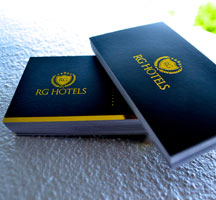
Usually the paper vs. plastic question is one that we only hear uttered by some bored teenager bagging groceries at the local supermarket.
When it comes to business cards, most of us didn’t realize we had an option. But with today’s ever-expanding printing world, it turns out we do. Plastic cards are printed on a material similar to that used by credit card companies, offering a sturdy product on a variety of backdrops – including clear, frosted, and white. Here, we’ll take a look at the advantages and disadvantages of each type of card.
Traditional paper, or cardstock business cards are actually not so very traditional anymore. Yes, standard full-color business cards still exist. These cards are 3.5 by 2 inches in dimension, and are printed on cardstock that ranges from 14pt thickness to higher quality 16pt thickness and above. These days, most business card printing companies offer full-color printing as a standard feature, although the quality of the inks and printing work can vary greatly.
Because it’s been the industry norm since the dawn of networking, business card printing offers some advantages that plastic business card printing can not yet boast. The main  advantage is options. Paper business card printing gives you tons of them. Here are some to consider.
advantage is options. Paper business card printing gives you tons of them. Here are some to consider.
Size: Paper business card printing can be done in sizes from 2.5×2.5 inches (to resemble a small square coaster), to 2×6 inches (for a bookmark-like card), to an oversized 3×4 inch card. These non-standard card sizes are often featured under the flyer printing menus on printing web sites, but are often printed with the same high quality 16pt cardstock that business cards are printed on (be sure to verify this before choosing a printing company to print your odd-sized business cards).
Finish: Paper business cards offer a host of unique finishes. Linen is one of these, and it’s also an extremely affordable option. As the name implies, linen business cards have a classic, natural, linen-like surface, making them a great choice for businesses that are going for a classic look.
In addition, there are silk-laminated paper business cards. These take the typical business card and add on a brushed plastic finish that resembles silk. The lamination renders the cards waterproof and tear proof, despite the paper base of the card.
Then there is spot UV finishing. This technique gives high shine gloss to certain areas of the business card, highlighting aspects of the paper card as the designer chooses. The effect is nearly three dimensional.
Finally, there are painted edge business cards. These cards go beyond the design space of the typical business card by incorporating the edges of the card as well. Seen on their side, these cards have a special color pop where most business cards are just blank.
On the other hand, there are benefits to printing plastic cards.
When you hand a client your plastic business card, you can be sure it will spark an instant reaction and heightened attention. He may think you mistakenly handed him a credit card or driver’s license, prompting him to take a close look right away. And so for the sheer fact that they’re dramatically different, plastic business cards are an easy attention-getter. Want a  bigger “Oooh?” Choose transparent cards. They make it look as though your contact information and designs are floating in space! Frosted plastic cards give your card an icy feel, while white is very clean – evocative of technology or the Apple Store, even.
bigger “Oooh?” Choose transparent cards. They make it look as though your contact information and designs are floating in space! Frosted plastic cards give your card an icy feel, while white is very clean – evocative of technology or the Apple Store, even.
Plastic Cards Are Beyond Durable
Talk about a card that stands the test of time – you can abuse your plastic cards pretty heavily without worry that they will no longer do the job. If you work in unpredictable weather or in an environment prone to spills, plastic cards are for you.
Paper or plastic? The card for your depends on your needs. If you’ve had a unique experience as a result of your plastic business cards, we’d love to hear about it, so please, send us your feedback!
Here are some examples of the cards mentioned above.